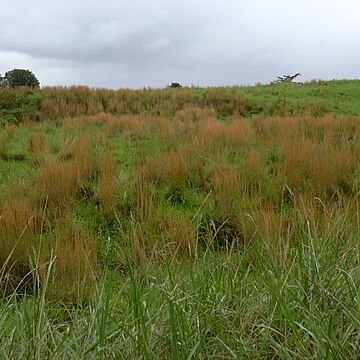Annual or perennial. Leaf blades linear, not aromatic; ligule scarious or reduced to a line of hairs. Inflorescence simple or compound; racemes fragile, usually paired, occasionally digitate or single, terminal on the culm or axillary and gathered into a spathate compound panicle; spikelets of a pair dissimilar; raceme bases not deflexed, without homogamous spikelets (present in A. munroi); rachis internodes filiform to linear or clavate, sometimes inflated, ciliate on margins. Sessile spikelet usually dorsally compressed; callus short, obtuse, shortly bearded, inserted into internode apex; lower glume membranous to leathery, 2-keeled, lanceolate, flat to concave with lateral keels, these sometimes narrowly winged, with or without intercarinal veins, or linear with dorsal keels and a deep veinless median groove; upper glume awned or awnless; lower floret reduced to a hyaline lemma; upper lemma hyaline, 2-lobed, awned from sinus; awn geniculate, column glabrous or puberulous. Stamens 1–3. Pedicelled spikelet variable, large to much reduced, male or barren. x = 10.
Spikelets of 2 kinds, in pairs (or trios) at joints of the rachis, one sessile and perfect, the other(s) pediceled and either staminate, neuter, abortive, or completely suppressed; glumes of the fertile spikelet equal or subequal, coriaceous, flat to concave on the back, lacking a midvein; fertile spikelet with 2 narrow, hyaline lemmas shorter than the glumes, the lower one empty and awnless, the upper one fertile and usually with an evident terminal awn; palea reduced and hyaline, or wanting; perennial, usually tufted, often glaucous, with elongate lvs; spikelets in racemes or spikes, these solitary, paired, digitate, or panicled, in our spp. mostly long-villous, the common peduncle usually subtended and often partly enclosed by a spathe-like lf. 100, widespread, mostly in warm reg.
Spikelets arranged in pairs at each node of a disarticulating rachis, one sessile and perfect, the other pedicellate and staminate, neuter, or sterile, often very much reduced, the rachis and sterile pedicels sparsely to usually densely ciliate or villous; glumes of sessile spikelet indurate, the first flat or rounded on the back, several-nerved, the median nerve obscure or wanting, the margins keeled toward the summit; sterile lemma hyaline; fertile lemma hyaline, narrow, much shorter than the glumes, awnless or usually awned from the apex or from between minute lobes, the awns straight, or geniculate and twisted below; pedicellate spikelets as large as the sessile, or more or less reduced, sometimes only the pedicel present, the glumes not indurate.
Racemes usually in pairs, sometimes solitary, arranged in a spatheate false panicle or in several subdigitate groups, usually exserted from the spatheoles; peduncles usually longer than the racemes, rarely the same length, erect at maturity; internodes and pedicels ± filiform or clavate, usually long-ciliate on both margins, occasionally inflated and canaliculate; lowermost pair of spikelets in the inferior raceme homogamous or not obviously different from the others.
Sessile spikelet dorsally or laterally compressed, narrowly ovate; callus often rounded; inferior glume with a ± deep median groove or ± flat on the back, muticous, mucronate or awned; superior glume usually keeled and flat or ± strongly convex on the back; inferior floret reduced to a hyaline lemma; superior floret bisexual, its lemma ± deeply bifid or entire, usually awned.
Pedicelled spikelet male or sterile, sometimes vestigial, very rarely absent.

